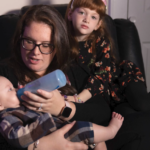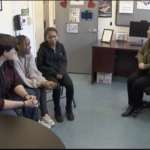As COVID-19 cases begin to surge across the country, again, questions surrounding when life will truly return to normal rise along with it. And yet, our current plight is anything but a mystery. Did we really think we had this thing beat in less than four months? Was reopening such a good idea?
As New York State’s numbers, once the epicenter of the pandemic, continue to decline the only thing that everyone (well, almost everyone) can agree on is that, no matter where you are, this is still far from over. In addition to the virus itself, according to the American Psychological Association COVID-19 aggravates existing mental health problems while potentially onsetting new symptoms– symptoms that can outlast the virus.
There is a universal trauma happening.
It’s been well documented that trauma occurs from war, oppression, natural disasters, and individual experiences. The current pandemic is no different, except it is a “mass trauma” filled with “anticipatory anxiety” on a worldwide scale. Without a cure or vaccine, society collectively wonders– will it come back? Is it safe to reopen? As more people file for unemployment and businesses continue to shut their doors, physical recovery is compounded with an eye on financial recovery. These anxieties are known as “peritraumatic”, occurring around the time of trauma in the form of intrusive thoughts.
Jessica Corea, a Licensed Mental Health Counselor, explained, “The world is experiencing a unifying trauma of loss and uncertainty. Patients are facing anxiety, depression, and financial stress all at the same time while trying to adapt to a new normal.” Even when the pandemic itself passes, it is sure to leave mass emotional destruction in its wake in the form of Post Traumatic Stress Disorder (PTSD), a classified mental disorder in the Diagnostic and Statistical Manual of Mental Disorders. Like any radical shift, the traumatic effects can go on for years.
Posttraumatic Stress Disorder can happen to anyone.
“Previous epidemic studies report high prevalence rates among people exposed to the trauma resulted from an infectious disease epidemic,” the National Center for Biotechnology Informationreported on June 5, 2020. Just like SARS, MERS, and HIV/AIDS, COVID-19 survivors are most at risk for PTSD, followed by family members who directly witnessed a loved one suffer or die, medical workers, and the general public. Further, the psychological trauma was categorized into three groups. First, directly experiencing the symptoms. Next, witnessing those who struggled. And third, experiencing a “realistic or unrealistic fear of infection, social isolation, exclusion, and stigmatization.” Essentially, like the virus itself, everyone is at risk.
“There is now a new normal that may be with us for a long time. Just as 911 impacted our lives in many ways so has this pandemic. I would certainly call this a traumatic event that has impacted everyone,” noted Elissa Smilowitz, Director of Triage and Emergency at North Shore Child & Family Guidance Center on Long Island.
Health experts across the globe are now preparing to treat patients with COVID-19 PTSD. Except the underlying issue is that PTSD symptoms don’t begin to develop until weeks or months after a traumatic event, and we are still in the middle of the pandemic itself. So, when does peritraumatic end and posttraumatic begin?
Medical News Today explains the four symptom types of PTSD are reexperiencing trauma, avoiding situations, negative changes in perception, and hyperarousal, in the forms of nightmares or flashbacks. Michigan Medicine’s Department of Psychiatry also reported, “PTSD is also associated with exaggerated activity in the brain networks associated with processing threat-detection and negative emotional responses.”
Reopening is contributing to a societal anxiety.
As cities across America roll back reopening, the response to COVID-19 is still being tackled on a state by state level. New York recently put gyms and malls on an indefinite pause while its New Jersey neighbor halted indoor dining. Meanwhile, in a reversal of events, New Jersey greeted shoppers at the local malls as Long Islanders enjoyed indoor dining at 50% capacity. In addition, New York, New Jersey, and Connecticut are now mandating a 14-day quarantine period for anyone traveling from 16 states– that’s double the amount originally reported only a week ago.
“The pandemic has really caused mental health struggles that I’ve never experienced. After postponing my wedding twice and losing two grandparents to COVID, all in less than a month, it feels strange that the world is trying to go back to normal so fast,” Long Island native Melissa Navon expressed of her personal struggles. “Nothing feels normal for me and the threat isn’t over yet. It’s difficult to explain how that feels to others who haven’t been personally affected. Many young people don’t think they need to wear masks. What they don’t understand, for some reason, is wearing a mask will protect those at risk. People like my grandparents might have survived this pandemic if everyone took the proper precautions.”
With no sense of stability or continuity mindsets are becoming increasingly fragile. After months of self-isolation reopening became a source of hope. The phases were planned, something to look forward to. Smilowitz said, “Some families are recognizing that the reopening is a good sign. However they are still anxious about whether these safety protocols will be enough.”
Focus on what you can control.
Beyond wondering how to behave there is continued concern over others behavior as well, as mask shaming trumps even political agendas. But the longer the pandemic goes on the less secure it all feels. Society is losing trust with its government and health officials, as new information spreads on a daily basis. Without a sense of guidance the internal battle to feel some sort of normalcy is lost.
Corea explained that early in the pandemic “patients were experiencing guilt for small aspects of joy” while others were suffering. Throughout, it has remained important for individuals to find balance and process fluctuating feelings. “It can shift within minutes given the current circumstances. Patients are encouraged to prioritize self-care and avoid running themselves down so they can be fully present, even if that means making a difficult decision to say no to others and setting more boundaries.”
Unlike scenarios of the past, isolation has been a key factor of the pandemic making traditional stress management unattainable. Something as simple as seeing loved ones can onset anxiety. But there are ways to cope.
“These thoughts don’t serve you. Live in the present, do not dwell. Having some control in your environment helps you feel more grounded and less anxious. Go slow, maybe just do one thing you would like to do and see how it feels,” advised Smilowitz.
How will we navigate PTSD in a post COVID world is yet to be seen, but experts across the board agree that for a large percentage of humanity it is inevitable. For a comprehensive list of ways to get ahead of COVID-19 PTSD, visit the U.S. Department of Veteran Affairs National Center For PTSD.














